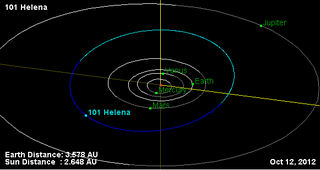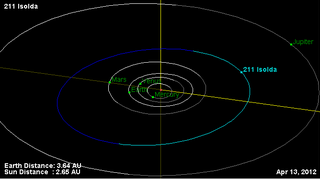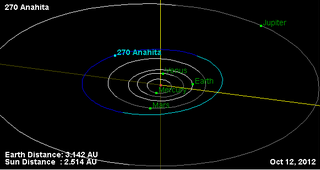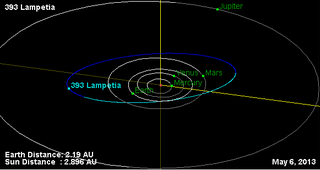
Leda is a large, dark main-belt asteroid that was discovered by French astronomer J. Chacornac on January 12, 1856, and named after Leda, the mother of Helen of Troy in Greek mythology. In the Tholen classification system, it is categorized as a carbonaceous C-type asteroid, while the Bus asteroid taxonomy system lists it as a Cgh asteroid. The spectra of the asteroid displays evidence of aqueous alteration.

Helena is a large, rocky main-belt asteroid. It was discovered by Canadian-American astronomer J. C. Watson on August 15, 1868, and was named after Helen of Troy in Greek mythology.

Felicitas is a dark and fairly large main-belt asteroid. It was discovered by German-American astronomer C. H. F. Peters on October 9, 1869, and named after Felicitas, the Roman goddess of success. The only observed stellar occultation by Felicitas is one from Japan.

Ate is a main-belt asteroid discovered by the German-American astronomer C. H. F. Peters on August 14, 1870, and named after Ate, the goddess of mischief and destruction in Greek mythology. In the Tholen classification system, it is categorized as a carbonaceous C-type asteroid, while the Bus asteroid taxonomy system lists it as an Ch asteroid.

Johanna is a large, dark main-belt asteroid that was discovered by French astronomers Paul Henry and Prosper Henry on 5 November 1872, and is believed to be named after Joan of Arc. It is classified as a CX-type asteroid, indicating the spectrum shows properties of both a carbonaceous C-type asteroid and a metallic X-type asteroid.

137 Meliboea is a large, dark main-belt asteroid that was discovered by Austrian astronomer J. Palisa at the Austrian Naval Observatory on 21 April 1874, the second of his many asteroid discoveries. It was later named after Meliboea, the daughter of Oceanus and Tethys in Greek mythology. The largest body in the Meliboea family of asteroids that share similar orbital elements, only 791 Ani approaches its size. It is classified as a C-type asteroid and may be composed of carbonaceous materials. The spectra of the asteroid displays evidence of aqueous alteration.

Isolda is a very large, dark main-belt asteroid. It is classified as a C-type asteroid and is probably composed of primitive carbonaceous material. The spectra of the asteroid displays evidence of aqueous alteration.

225 Henrietta is a very large outer main-belt asteroid. It was discovered by Austrian astronomer Johann Palisa on April 19, 1882, in Vienna and named after Henrietta, wife of astronomer Pierre J. C. Janssen. The asteroid is orbiting at a distance of 3.39 AU from the Sun with a period of 6.24 years and an eccentricity (ovalness) of 0.26. The orbital plane is inclined at an angle of 20.9° to the plane of the ecliptic. 225 Henrietta belongs to Cybele group of asteroids and is probably in a 4:7 orbital resonance with the planet Jupiter.

Eukrate is a rather large main-belt asteroid. It is dark and probably a primitive carbonaceous body. The asteroid was discovered by Robert Luther on March 14, 1885, in Düsseldorf. It was named after Eucrate, a Nereid in Greek mythology.

Aline is a fairly large main belt asteroid that was discovered by Johann Palisa on 17 May 1887 in Vienna and is thought to have been named after the daughter of astronomer Edmund Weiss. It is a dark C-type asteroid and is probably composed of primitive carbonaceous material. 266 Aline is orbiting close to a 5:2 mean motion resonance with Jupiter, which is located at 2.824 AU.

Anahita is a stony S-type Main belt asteroid. It was discovered by C. H. F. Peters on October 8, 1887, in Clinton, New York, and was named after the Avestan divinity Aredvi Sura Anahita.

Chaldaea is a large Main belt asteroid. It is classified as a C-type asteroid and is probably composed of carbonaceous material. It was discovered by Johann Palisa on 30 August 1891 in Vienna. It was named in honor of the Chaldeans, considered the founders of astrology.

Lacadiera is a large Main belt asteroid. It is classified as a D-type asteroid and is probably composed of organic rich silicates, carbon and anhydrous silicates. The asteroid was discovered by Auguste Charlois on 19 September 1892 in Nice.

Lampetia is a fairly large main belt asteroid that was discovered by German astronomer Max Wolf on 4 November 1894 in Heidelberg. It has an unusually low rotation rate, with a period estimated at 38.7 hours and a brightness variation of 0.14 in magnitude.
Thia is a very large main-belt asteroid. It is classified as a C-type asteroid and is probably composed of carbonaceous material. This object was discovered by Auguste Charlois on July 23, 1895, in Nice, and was named after Theia, a Titaness in Greek mythology.
Lotis is a large Main belt asteroid. It is classified as a probable C-type asteroid and is likely composed of primitive carbonaceous materials. This object was discovered by Auguste Charlois on 23 November 1897 in Nice.
Kreusa is a C-type asteroid orbiting the Sun in the asteroid belt, with the type indicating a surface with a low albedo and high carbonaceous content. The spectra of the asteroid displays evidence of aqueous alteration.
622 Esther is a minor planet orbiting the Sun.
654 Zelinda is a minor planet orbiting the Sun that was discovered on 4 January 1908 by German astronomer August Kopff. On favorable oppositions, it can be as bright as magnitude 10.0, as on January 30, 2016.
758 Mancunia is a minor planet orbiting the Sun. It was discovered in 1912 from Johannesburg by H. E. Wood, a Mancunian. This object is orbiting at a distance of 3.19 AU with a period of 5.70 years and an eccentricity (ovalness) of 0.15. The orbital plane is inclined at an angle of 5.61° to the plane of the ecliptic.














